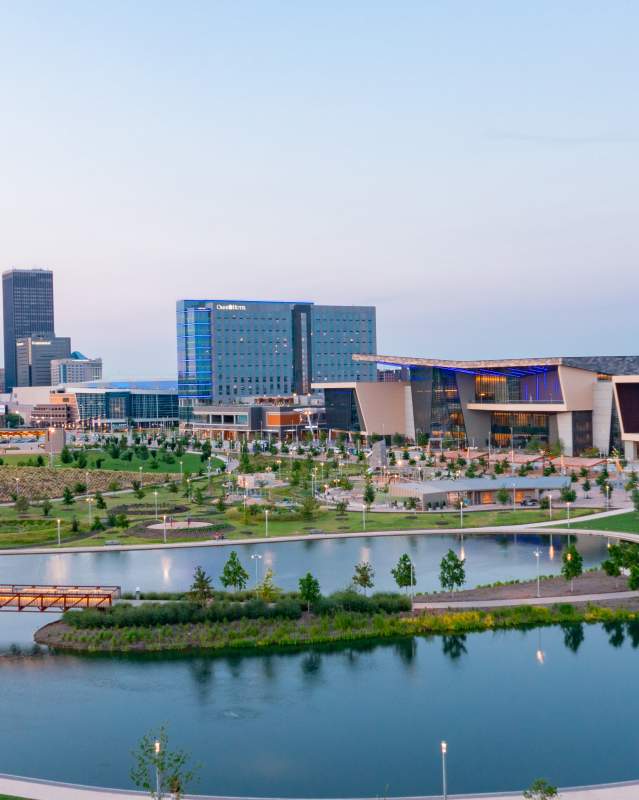OKLAHOMA CITY – Visitors to downtown Oklahoma City can enjoy a new work of public art, “Folded Circle Split” by Fletcher Benton. This already-iconic nine-foot-tall bronze sculpture, which Benton created in 1984, is the inaugural sculpture in Carolyn Hill Park on the southeast side of the Oklahoma City Museum of Art. The sculpture was given by Jon and Molly Ott in honor of the Museum’s 75th anniversary. Carolyn Hill Park is generously sponsored by the Tom and Judy Love Family in memory of Carolyn Hill.
“Our dynamic Arts District continues to grow and change,” said Michael J. Anderson, Ph.D., OKCMOA president and CEO. “We are proud to be at the heart of the district and to provide world-class art experiences for Oklahoma City. ‘Folded Circle Split’ is an important work by a major American artist that both visitors and residents can enjoy anytime downtown. We would like to thank Jon and Molly Ott and Love’s Travel Stops & Country Stores for their great generosity and their vision for the Museum and our city.”
During the “Gifts for 75” campaign, the Museum was gifted the iconic large-scale bronze sculpture “Folded Circle Split” by famed American artist Fletcher Benton (1931-2019), adding to the Museum’s strong collection of postwar sculpture. “Folded Circle Split” is part of a major series by the artist that sought to create new spatial meanings through the simple gestures of cutting and bending flat circular forms.
This is the second-largest bronze Benton sculpture in the world and provides dramatically different profiles from different angles. It was installed July 3 as the inaugural sculpture for Carolyn Hill Park, directly outside the Museum’s theater entrance.
OKCMOA has a strong collection of postwar art, including Benton’s “Folded Quarter Circle Red” (1976). “Folded Circle Split” strengthens this collection and provides a year-round public artwork to enhance the Museum’s presence downtown.
Fletcher Benton
Benton lived in San Francisco during the 1950s and ‘60s and worked as a commercial sign painter by day and an expressionist painter by night. In 1961, he had a solo exhibition at the California Palace Legion of Honor and showed his portraits of fellow artists. After growing frustrated with the limitations of two-dimensional painting, Benton began to experiment with movement in geometric pattern pieces and boxes. This was at the beginning of the kinetic movement, yet Benton worked largely in isolation, unaware of the efforts of other kinetic artists.
In the 1970s, Benton abandoned kinetic art, switching to more traditional media for sculpture: bronze and steel. These works, such as “Folded Circle Split,” are designed to be viewed from all angles and have often been characterized as new constructivism. Benton’s large-scale steel sculptures are permanently installed at the Metropolitan Museum of Art, the Hirshhorn Museum and Sculpture Garden in Washington, D.C. and the Los Angeles County Museum of Art.
Carolyn Hill Park
The small urban greenspace outside the Museum bears the name of Carolyn Hill, who led the Oklahoma City Museum of Art from 1994 to 2008. Hill was a native Oklahoman who had a successful 30-year career in the New York City art world before returning home. She found the Oklahoma City art scene divided but under her leadership, a stronger unified community emerged. As downtown experienced a renaissance inspired by the MAPS Projects of the 1990s, Hill worked tirelessly to promote a Downtown presence for an art museum and raised funding to transform the old Centre Theatre into the Reynolds Visual Arts Center – a modern art museum for a modern city. In honor of her efforts, this park was designated Carolyn Hill Park by the city council in 2012.
|
About the Oklahoma City Museum of Art The Oklahoma City Museum of Art is one of the leading arts institutions in the region. The Museum presents a dynamic range of exhibitions organized from prestigious museums and collections throughout the world. The Museum’s own diverse collection features highlights from North America, Europe and Asia, with particular strengths in American art and postwar abstraction. The permanent collection also boasts one of the world’s largest public collections of Dale Chihuly glass, a major collection of photography by Brett Weston and the definitive museum collection of works by the Washington Color painter Paul Reed. The Museum’s renowned Samuel Roberts Noble Theater screens the finest international, independent, documentary and classic films. The Oklahoma City Museum of Art is accredited by the American Alliance of Museums and is a member of the Association of Art Museum Directors. The Museum serves over 125,000 visitors annually from all fifty states and thirty foreign countries. |






